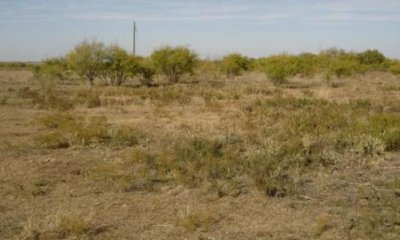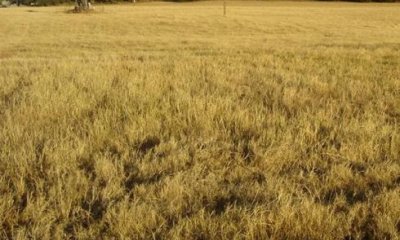
Sandy Loam 25-28" PZ
Scenario model
Current ecosystem state
Select a state
Management practices/drivers
Select a transition or restoration pathway
-
Transition T1A
Absence of disturbance and natural regeneration over time, may be coupled with excessive grazing pressure
More details -
Transition T1B
Extensive soil disturbance followed by seeding
More details -
Restoration pathway R2A
Adequate rest from defoliation, followed by reintroduction of historic disturbance regimes
More details -
Transition T2A
Absence of disturbance and natural regeneration over time, may be coupled with excessive grazing pressure
More details -
Transition T2B
Extensive soil disturbance followed by seeding
More details -
Restoration pathway R3A
Adequate rest from defoliation and removal of woody canopy
More details -
Transition T3A
Extensive soil disturbance followed by seeding
More details -
Restoration pathway R4A
Absence of disturbance and natural regeneration over time, may be coupled with drought
More details -
Restoration pathway R4B
Absence of disturbance and natural regeneration over time, may be coupled with drought
More details -
No transition or restoration pathway between the selected states has been described
Target ecosystem state
Select a state
State 1
Tallgrass/Midgrass Savanna State





Description
Historically, the Tallgrass/Midgrass Savanna Community consisted of a diverse mixture of tallgrasses and midgrasses, a minor but significant shortgrass component, an abundance of forbs, with trees and shrubs distributed throughout the landscape. In pristine conditions, little bluestem is the dominant grass with a significant amount of other tallgrasses. Midgrasses such as sideoats grama, Arizona cottontop, silver bluestem, and Texas wintergrass are also a significant component. A wide variety of forbs such as Engelmann daisy, gayfeather, prairie clover, bundleflower, and daleas occurs. Mottes of liveoak and individual trees of post oak, hackberry, and elm are distributed throughout the site. Shrubs such as flameleaf sumac, skunkbush sumac, and bumelia are also scattered across the landscape.
In the Little Bluestem Savanna Community, Indiangrass, big or sand bluestem, switchgrass, and sand lovegrass begin to decline and their presence is significantly reduced. Little bluestem becomes very dominant and may comprise as much as 60% of the total plant community in this phase. Sideoats grama also tends to increase somewhat in this initial stage of retrogression. Species composition of forbs, shrubs, and trees generally remains static in this phase.
Tallgrasses such as Indiangrass, big bluestem, and switchgrass are drastically reduced in the Midgrass Community. Remnant populations and widely scattered individual tallgrass species remain in protected areas. They are often unnoticed because they are grazed very short, are in low vigor, and are not prominent on the site. Midgrasses such as sideoats grama, Arizona cottontop, silver bluestem, and Texas wintergrass become dominant. Perennial forbs increase. Mesquite, pricklypear, and other woody species gradually begin to increase in density and canopy as they encroach from adjacent sites.
Submodel
Description
The Shortgrass/Annual Forb Community is marked by continued deterioration of the plant community due to abusive grazing and/or other destructive disturbances eventually results in a plant community dominated by shortgrasses and midgrasses. Bare ground can become significant in the most deteriorated state. Tallgrass species and many of the midgrass species no longer exist in sufficient amounts to allow the site to recover through management alone.
Submodel
Description
The Shrubland State has seen an increase in annual forbs and grasses. There is also an increase of brush species such as mesquite, lotebush, catclaw acacia, greenbriar, pricklypear, and tasajillo become well established eventually developing a canopy of more than 20% on the site.
Submodel
Description
Hundreds of thousands of acres have been plowed up and converted to cropland, pastureland, or hayland or also known as the Converted Land Community. Bermudagrass is the primary introduced species used in this area. The Sandy Loam site can be an extremely productive forage producing site with the application of optimum amounts of fertilizer. Refer to Forage Suitability Group Descriptions for specific recommendations, production potentials, species adaptation, etc. In some localized areas, several hundred acres of pecan and peach orchards have been established on the sandy loam soils related to this site.
Abandoned croplands and reseeded areas tend to revert back to a more natural state through the process of secondary succession. This plant community is also known as Abandoned Land CommunityThe first plants to establish are annual forbs and grasses followed by early successional shortgrasses and midgrasses. If managed properly, some of these abandoned areas may eventually begin to approximate the diversity and complexity of the native Sandy Loam ecosystem.
Submodel
Mechanism
Long-term abusive grazing and a lack of fire will eventually result in the transition from a midgrass plant community to a plant community dominated by shortgrasses and annuals. Sideoats grama, Arizona cottontop, and vine mesquite decline drastically. Shortgrasses, such as buffalograss, hairy grama, Texas grama, and threeawns become the dominant grasses. Silver bluestem and dropseeds become the primary midgrasses in this phase. Opportunistic species such as broomweed, other annual forbs, and annual grasses invade the site as bare ground increases. Non-native and invasive shrubs begin to increase on the site and invade from adjacent sites. The increase in density and woody canopy of shrubs begins to have an adverse effect on the understory herbaceous vegetation because of increased shading and competition for space and soil moisture.
Mechanism
Thousands of acres of the native vegetation on this site have been “broken out” and converted to other land uses such as cropland, introduced pasture, seeded monocultures of native grasses, or orchard land. This is a favored site for conversion due to the relatively deep and fertile soils as well as the flat to gently rolling topography. Seedbed preparation can be accomplished with normal cultivation equipment and desired vegetation can be seeded or planted.
Mechanism
At this stage, there is no longer a viable population of the original tallgrasses and primary midgrasses to reproduce sufficient seed to enable the plant community to recover through management practices alone. Brush management is needed when the density and canopy of shrubs and trees begins to have an adverse effect on the desired grasses and forbs. Brush management treatment methods become more complicated, more expensive, and less effective. At this stage, Range Planting will be required to re-introduce the original midgrasses and tallgrasses. Implementation of a grazing management plan is necessary to allow establishment of seeded vegetation and control the timing, frequency, duration, and degree of grazing following establishment. Prescribed burning will assist with the recovery and maintenance of the desired plant community.
Relevant conservation practices
| Practice | External resources |
|---|---|
|
Brush Management |
|
|
Prescribed Burning |
|
|
Prescribed Grazing |
|
|
Range Planting |
Mechanism
Continued abusive grazing, lack of fire, extended drought, and lack of brush management will result in a plant community which is dominated by shrubs including mesquite, lotebush, catclaw acacia, pricklypear, yucca, and tasajillo. The woody canopy has a detrimental effect on the understory vegetation. Extensive areas of bare ground may occur. Shortgrasses as well as annual grasses and forbs increase dramatically and invade from adjacent sites. Texas wintergrass and other shade tolerant species increase. Once the site has declined to this stage, it will not return to a higher state of vegetation through management practices alone.
Mechanism
This plant community can be converted to cropland, introduced pasture, or orchard land, but it may require mechanical brush management to remove unwanted shrubs and trees if they are dense enough to interfere with seedbed preparation, seeding or planting operations, or management following establishment. Seedbed preparation methods may require heavier equipment, and seeding or planting methods may have to be modified to overcome more intensive land preparation treatments.
Mechanism
It is probably not practical or economically feasible to attempt to restore the original plant community through brush management and revegetation. However, brush management can be carried out in selected areas to open up the canopy and reduce tree density to improve wildlife habitat, improve growing conditions for herbaceous vegetation, and provide access. Brush management followed by seeding or planting native vegetation can be expected to establish a healthy plant community that contains many of the original native grasses, but lacks the diversity of forbs and minor grasses found in the reference plant community. Implementation of a grazing management plan is necessary to allow establishment of seeded vegetation and control the timing, frequency, duration, and degree of grazing following establishment. Prescribed burning will assist with the recovery and maintenance of the desired plant community.
Relevant conservation practices
| Practice | External resources |
|---|---|
|
Brush Management |
|
|
Prescribed Burning |
|
|
Prescribed Grazing |
|
|
Range Planting |
Mechanism
Extensive brush management and seedbed preparation techniques with heavy equipment are required to clear the land in order to convert it to cropland, introduced pasture, or seeded monocultures at this point. These treatments are radical, expensive, and generally not recommended.
Mechanism
After conversion to other land uses, these areas must be intensively managed in order to maintain production and quality. Economics, drought, and other outside factors may result in these areas being abandoned or neglected. If fertility is not maintained, and weed control is not routinely carried out, the land may revert to shortgrasses and early successional forbs and grasses.
Mechanism
After conversion to other land uses, these areas must be intensively managed in order to maintain production and quality. Economics, drought, and other outside factors may result in these areas being abandoned or neglected. If fertility is not maintained, weed control is not routinely carried out, and invasive shrubs and trees are not controlled, the land may revert to a shrubland state with a canopy cover of more than 20% and an understory of early successional shortgrasses and forbs.
Model keys
Briefcase
Add ecological sites and Major Land Resource Areas to your briefcase by clicking on the briefcase (![]() ) icon wherever it occurs. Drag and drop items to reorder. Cookies are used to store briefcase items between browsing sessions. Because of this, the number of items that can be added to your briefcase is limited, and briefcase items added on one device and browser cannot be accessed from another device or browser. Users who do not wish to place cookies on their devices should not use the briefcase tool. Briefcase cookies serve no other purpose than described here and are deleted whenever browsing history is cleared.
) icon wherever it occurs. Drag and drop items to reorder. Cookies are used to store briefcase items between browsing sessions. Because of this, the number of items that can be added to your briefcase is limited, and briefcase items added on one device and browser cannot be accessed from another device or browser. Users who do not wish to place cookies on their devices should not use the briefcase tool. Briefcase cookies serve no other purpose than described here and are deleted whenever browsing history is cleared.
Ecological sites
Major Land Resource Areas
The Ecosystem Dynamics Interpretive Tool is an information system framework developed by the USDA-ARS Jornada Experimental Range, USDA Natural Resources Conservation Service, and New Mexico State University.










